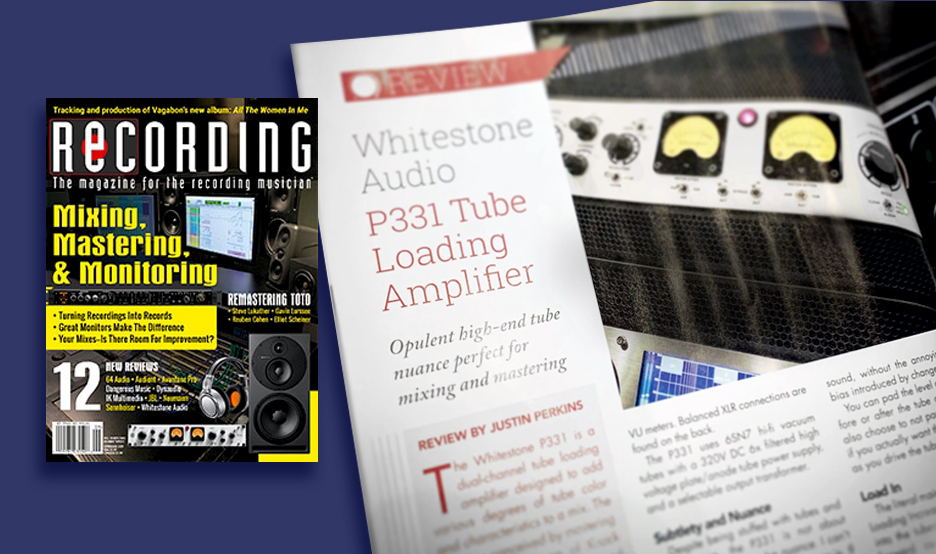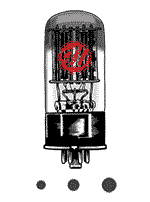
Whitestone Audio
P331 Tube Loading Amplifier
Opulent high-end tube nuance perfect for mixing and mastering
Review by Justin Perkins

The Whitestone P331 is a dual-channel tube loading amplifier designed to add various degrees of tube color and characteristics to a mix. The unit was conceived by mastering engineer Kim Rosen of Knack Mastering in Ringwood, NJ, and brought to fruition with the help of her husband, Dave Rosen. While its build, feature set, and price tag are destined primarily for the mastering community, the P331 is suited for mixing and recording as well.
Introductions
The P331 is a 2U, 19” rack device finished in classy white enamel, with matching left and right channels. Every one of its eight knobs and ten switches are fully stepped for repeatable, channel-matched results. Internally, it makes use of 80 precision relays, with no audio passing through any of the front panel controls, which are: Loading, Lift, XFormer, Gain, Mode, and Resolution. The unit features two large, ultra-sensitive, level-selectable VU meters. Balanced XLR connections are found on the back.
The P331 uses 6SN7 hi-fi vacuum tubes with a 320V DC 6x filtered high voltage plate/anode tube power supply, and custom transformers.
Subtlety and Nuance
Despite being stuffed with tubes and transformers, the P331 is not about tube grit, it’s about tube nuance. I can’t overstate how subtle this processor is. If you’re looking for a processor with edgy and crispy saturation, this might not be the one for you.
Pre-Post-Open
Back in my mixing days, I’d sometimes use an Ampex 351 Tape Recorder preamp to saturate a signal, but there wasn’t an elegant way to lower the output—mildly annoying. This unit solves that.
The P331 was developed around a concept that I’ve always wanted to see made real in a processor like this—the ability to automatically pad the signal as you drive the tubes and circuits harder, thus providing a stabilized, unchanging listening level. This feature allows you to really hear how the unit is affecting the sound, without the annoying personal bias introduced by changes in loudness.
You can pad the level down either before or after the tube circuits. You can also choose to not pad the signal at all if you actually want the level to increase as you drive the tubes—I didn’t use that feature in practice though.
Load In
The literal main thrust of the P331 is the Loading Increase knob that drives sound into the tubes. This is a pretty straightforward control, and it’s connected to the most useful feature on the unit to me: the Clean/Bloom toggle switch, which changes the tube interaction between feedback or feedforward.
Liftoff
The Lift knob is like an EQ that enhances either the lows, the highs, or both. It comes before the tube processing, and there’s no control over the frequency choices. It will either fit a track or it won’t, but every now and then, one of these Lift settings offered just the right amount of low or high frequency enhancement that a song needed, obviating the need to reach for an EQ.
Xformer
You can choose to use this unit in its default transformerless state, or you can send audio into a custom output transformer and select between two different modes of transformer loading.
Boost-Cut-Gain
There’s also a ‘clean’ output gain stage for boosting or cutting level at the very end of the signal path if you need to. It’s set up in 1dB increments, and also includes a three-position Resolution switch to back down the signal a further 0.25dB or 0.5dB if you need that level of control. Here, I would have preferred a variable knob as opposed to the fixed toggle option.
Mastering Room
One thing I learned is that nearly every P331 control offers a certain element of unpredictability. You really have to experiment and see what settings are going to work on any given song. Something that worked really well on one track might actually make another track sound worse, or too different.
For example, I had a mix that came in really warm and overly thick—it didn’t strike me as a good candidate for this unit. However, after correcting the mix with EQ before hitting the P331, the unit worked wonderfully to help prevent things from getting too sterile.
I also mastered a modern rock Foo Fighters-esque single that had no technical problems and sounded totally acceptable. However, I knew that the band had recorded it themselves in their project studio, and that the mix engineer was fairly robotic in his work and leaned heavily on drum samples and amp simulators. Again, it sounded totally fine, but had no edge or character to it—it was just a little too clean and clinical. Using the P331, I was able to dial in just the right amount of character to make the song sound more appropriate for the genre, and the band approved it on the first pass.
The P331 is great at adding the things I generally love about tube equipment, but without the typical negative characteristics such as killing drum transients and being too slow-sounding.
If you have a tube EQ or compressor that you think sounds good set flat, and you don’t actually use any of its controls, then the P331 might be perfect for you.
I connected the unit to an insert point on my mastering console, which has a wet/dry blend control, and it proved really useful at times; as such, I think a built-in wet/dry mix control would be a great feature on the P331.
I’m a mastering engineer, so I would have preferred to have ganged L/R controls on the P331. That said, I concede that since this unit is also designed for tracking, I can understand the dual mono configuration having its uses in that scenario.
One other nitpick I had is the functionality of the clever but tricky momentary contact switch that changes the auto-padding between pre, open, and post. I found myself wanting to toggle between pre and post, but the open position falls between them, so the level changes dramatically for split second as open mode is engaged. Not a deal-breaker, but I did make note of it.
As mentioned, in use the P331 is very subtle in nature and I would suggest giving the unit pride of place in the center of your desk, where you can focus in accurately and hear all the subtleties in your ideal listening position.
Conclusions
Overall, I really loved the P331 and I ended up using it on more tracks than I expected. I should also note that for a tube unit, the noise floor is very low. It’s hand-built in the USA, and from the moment I picked up the box I could tell by the weight of it that this was an extremely solid and quality unit. Plugging it in more than confirmed my assumptions.
More From: whitestoneaudio.com
Price: $4999
Mixing Side Bar*
Paul Vnuk Jr.
After Justin put the P331 through its paces in mastering for a few weeks, I was eager to get the unit into my own studio for some mixing duties. The two words Justin used above, ‘subtle’ and ‘unpredictable’, are totally appropriate. For those reasons alone it makes a great choice on the master bus, especially if you work primarily in the box. This is not a buzzy, fuzzy tube saturator. As Justin said, it’s more akin to running your mix back through the tube input section of an old tape machine, or a tube compressor with the controls set flat.
Tube-subtle is good on the 2-bus because it can do its duty as an anti-sterility machine, but still keep your mix sounding like your mix, with no gimmicky, heavy-handed artifacts that only get in the way of the mastering engineer’s process.
On the subject of unpredictability, it’s not that the P331 will or won’t work on a mix, it’s that some of its processes and settings may do different things and be more or less useful than others when moving from mix to mix and genre to genre.
For instance, I still can’t tell you concretely what Clean or Bloom actually sounds like or what they do to the signal, and it’s almost the same with the two XFormer settings and the Pre and Post auto-pad settings. The techie in me ‘gets’ what they should be doing in theory, but they don’t always behave in a prescribed manner, and sometimes I simply just like one better than the other. All in all, the P331 sounds so good and hi-fi, I am ok with it having a mind of its own!


